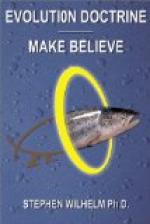With these general results in mind, we must now become acquainted with such subjects as the interpretation of fossils, the causes for the incompleteness of the series, the conditions for fossilization, the forces of geological nature, and other matters that make the fossils themselves intelligible as scientific evidence.
* * * * *
Many views have been entertained regarding the actual nature of the relics of antiquity exhumed from the rocks or exposed upon the surface by the wear and tear of natural agencies. In earliest times such things were variously considered as curious freaks of geological formation, as sports of nature, or as the remains of the slain left upon the battle-ground of mythical Titans. Some of the Greeks supposed that fossils were parts of animals formed in the bowels of the earth by a process of spontaneous generation, which had died before they could make their way to the surface. They were sometimes described as the bones of creatures stranded upon the dry land by tidal waves, or by some such catastrophe as the traditional flood of the scriptures. In medieval times, and even in our own day, some people who have been opposed to the acceptance of any portion of the doctrine of evolution have actually defended the view that the things called fossils were never the shells or bones of animals living in bygone times, but that they only simulate such things and have been created as such together with the layers of rock from which they may have been taken. If we employed the same arguments in dealing with the broken fragments of vases and jewelry taken from the Egyptian tombs or from the buried ruins of Pompeii, we would have to believe that such pieces were created as fragments and that they were never portions of complete objects, just because no one alive to-day has ever seen the perfect vessel or bracelet fashioned so long ago. Common sense directs us to discard such a fantastic interpretation in favor of the view that fossils are what they seem to be—simply relics of creatures that lived when the earth was younger.
Until this common sense view was adopted there was no science of palaeontology. Cuvier was the first great naturalist to devote particular attention to the mainly unrelated and unverified facts that had been discovered before his time. He was truly the originator of this branch of zooelogy, for he brought together the observations of earlier men and extended his own studies widely and surely, emphasizing particularly the necessity for noting carefully the geological situation of a fossil in rocks of an older or later period of formation. His great result was the demonstration that many groups of animals existed in earlier ages that seem to have no descendants of the same nature to-day, and also that many or most of our modern groups are not represented in the earliest formed sedimentary rocks, although these recent forms possess hard parts which would surely be present somewhere




